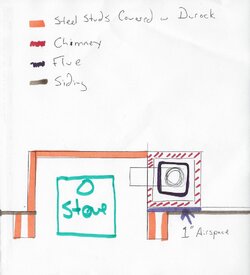Looking at choice "B" on the attached photo. Is a tee snout considered the "Chimney connector" and can a class A chimney pipe be considered "listed factory build chimney length". If so does that mean a Tee Snout will pass through a class A Chimney pipe? These descriptions confuse me on what they mean by Factory Built Chimney connector.
Does a Tee Snout pass through a Class A Chimney Pipe?
- Thread starter Dajolu
- Start date
-
Active since 1995, Hearth.com is THE place on the internet for free information and advice about wood stoves, pellet stoves and other energy saving equipment.
We strive to provide opinions, articles, discussions and history related to Hearth Products and in a more general sense, energy issues.
We promote the EFFICIENT, RESPONSIBLE, CLEAN and SAFE use of all fuels, whether renewable or fossil.



